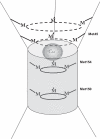Copper transporters and the cellular pharmacology of the platinum-containing cancer drugs
- PMID: 20159940
- PMCID: PMC3202487
- DOI: 10.1124/mol.109.063172
Copper transporters and the cellular pharmacology of the platinum-containing cancer drugs
Abstract
Multiple lines of evidence indicate that the platinum-containing cancer drugs enter cells, are distributed to various subcellular compartments, and are exported from cells via transporters that evolved to manage copper homeostasis. The cytotoxicity of the platinum drugs is directly related to how much drug enters the cell, and almost all cells that have acquired resistance to the platinum drugs exhibit reduced drug accumulation. The major copper influx transporter, copper transporter 1 (CTR1), has now been shown to control the tumor cell accumulation and cytotoxic effect of cisplatin, carboplatin, and oxaliplatin. There is a good correlation between change in CTR1 expression and acquired cisplatin resistance among ovarian cancer cell lines, and genetic knockout of CTR1 renders cells resistant to cisplatin in vivo. The expression of CTR1 is regulated at the transcriptional level by copper via Sp1 and at the post-translational level by the proteosome. Copper and cisplatin both trigger the down-regulation of CTR1 via a process that involves ubiquitination and proteosomal degradation and requires the copper chaperone antioxidant protein 1 (ATOX1). The cisplatin-induced degradation of CTR1 can be blocked with the proteosome inhibitor bortezomib, and this increases the cellular uptake and the cytotoxicity of cisplatin in a synergistic manner. Copper and platinum(II) have similar sulfur binding characteristics, and the presence of stacked rings of methionines and cysteines in the CTR1 trimer suggest a mechanism by which CTR1 selectively transports copper and the platinum-containing drugs via sequential transchelation reactions similar to the manner in which copper is passed from ATOX1 to the copper efflux transporters.
Figures



Similar articles
-
Contribution of the major copper influx transporter CTR1 to the cellular accumulation of cisplatin, carboplatin, and oxaliplatin.Mol Pharmacol. 2006 Oct;70(4):1390-4. doi: 10.1124/mol.106.022624. Epub 2006 Jul 17. Mol Pharmacol. 2006. PMID: 16847145
-
Role of human copper transporter Ctr1 in the transport of platinum-based antitumor agents in cisplatin-sensitive and cisplatin-resistant cells.Mol Cancer Ther. 2004 Dec;3(12):1543-9. Mol Cancer Ther. 2004. PMID: 15634647
-
Modulation of the cellular pharmacology of cisplatin and its analogs by the copper exporters ATP7A and ATP7B.Mol Pharmacol. 2004 Jul;66(1):25-32. doi: 10.1124/mol.66.1.25. Mol Pharmacol. 2004. PMID: 15213293
-
The roles of copper transporters in cisplatin resistance.Cancer Metastasis Rev. 2007 Mar;26(1):71-83. doi: 10.1007/s10555-007-9045-3. Cancer Metastasis Rev. 2007. PMID: 17318448 Review.
-
Copper transporters regulate the cellular pharmacology and sensitivity to Pt drugs.Crit Rev Oncol Hematol. 2005 Jan;53(1):13-23. doi: 10.1016/j.critrevonc.2004.09.007. Crit Rev Oncol Hematol. 2005. PMID: 15607932 Review.
Cited by
-
Mithplatins: Mithramycin SA-Pt(II) Complex Conjugates for the Treatment of Platinum-Resistant Ovarian Cancers.ChemMedChem. 2023 Feb 1;18(3):e202200368. doi: 10.1002/cmdc.202200368. Epub 2022 Nov 22. ChemMedChem. 2023. PMID: 36342449 Free PMC article.
-
Mice with a Sertoli cell-specific knockout of the Ctr1 gene exhibit a reduced sensitivity to cisplatin-induced testicular germ cell apoptosis.Toxicol Res (Camb). 2019 Nov 8;8(6):972-978. doi: 10.1039/c9tx00142e. eCollection 2019 Nov 1. Toxicol Res (Camb). 2019. PMID: 32665841 Free PMC article.
-
Mechanisms of drugs-resistance in small cell lung cancer: DNA-related, RNA-related, apoptosis-related, drug accumulation and metabolism procedure.Transl Lung Cancer Res. 2020 Jun;9(3):768-786. doi: 10.21037/tlcr-19-547. Transl Lung Cancer Res. 2020. PMID: 32676338 Free PMC article. Review.
-
Cellular Pharmacology of Palladinum(III) Hematoporphyrin IX Complexes: Solution Stability, Antineoplastic and Apoptogenic Activity, DNA Binding, and Processing of DNA-Adducts.Int J Mol Sci. 2018 Aug 19;19(8):2451. doi: 10.3390/ijms19082451. Int J Mol Sci. 2018. PMID: 30126243 Free PMC article.
-
Evidence that fodipir (DPDP) binds neurotoxic Pt2+ with a high affinity: An electron paramagnetic resonance study.Sci Rep. 2019 Nov 1;9(1):15813. doi: 10.1038/s41598-019-52248-9. Sci Rep. 2019. PMID: 31676855 Free PMC article.
References
-
- Arredondo M, Muñoz P, Mura CV, Nùñez MT. DMT1, a physiologically relevant apical Cu1+ transporter of intestinal cells. Am J Physiol Cell Physiol. 2003;284:C1525–C1530. - PubMed
-
- Beretta GL, Gatti L, Tinelli S, Corna E, Colangelo D, Zunino F, Perego P. Cellular pharmacology of cisplatin in relation to the expression of human copper transporter CTR1 in different pairs of cisplatin-sensitive and -resistant cells. Biochem Pharmacol. 2004;68:283–291. - PubMed
-
- Dancis A, Haile D, Yuan DS, Klausner RD. The Saccharomyces cerevisiae copper transport protein (Ctr1p). Biochemical characterization, regulation by copper, and physiologic role in copper uptake. J Biol Chem. 1994;269:25660–25667. - PubMed
Publication types
MeSH terms
Substances
Grants and funding
LinkOut - more resources
Full Text Sources
Other Literature Sources
Molecular Biology Databases
Research Materials
Miscellaneous

